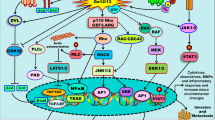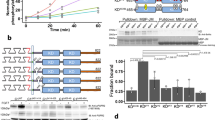Abstract
G Proteins provide signal transduction mechanisms to seven transmembrane receptors. Recent studies have indicated that the α-subunits as well as the βγ-subunits of these proteins regulate several critical signaling pathways involved in cell proliferation, differentiation and apoptosis. Of the 17 α-subunits that have been cloned, at least ten of them have been shown to couple mitogenic signaling in fibroblast cells. Activating mutations in Gαs, Gαi2, and Gα12 have been correlated with different types of tumors. In addition, the ability of the βγ-subunits to activate mitogenic pathways in different cell-types has been defined. The present review briefly summarizes the diverse and novel signaling pathways regulated by the α- as well as the βγ-subunits of G proteins in regulating cell proliferation.
This is a preview of subscription content, access via your institution
Access options
Subscribe to this journal
Receive 50 print issues and online access
$259.00 per year
only $5.18 per issue
Buy this article
- Purchase on SpringerLink
- Instant access to full article PDF
Prices may be subject to local taxes which are calculated during checkout
Similar content being viewed by others
Author information
Authors and Affiliations
Rights and permissions
About this article
This article is cited by
-
MiR-30c-5p-Targeted Regulation of GNAI2 Improves Neural Function Injury and Inflammation in Cerebral Ischemia-Reperfusion Injury
Applied Biochemistry and Biotechnology (2023)
-
Loss of Gαi proteins impairs thymocyte development, disrupts T-cell trafficking, and leads to an expanded population of splenic CD4+PD-1+CXCR5+/− T-cells
Scientific Reports (2017)
-
Suppression of GNAI2 message in ovarian cancer
Journal of Ovarian Research (2014)
-
Identification and experimental validation of G protein alpha inhibiting activity polypeptide 2 (GNAI2) as a microRNA-138 target in tongue squamous cell carcinoma
Human Genetics (2011)
-
Gonadotropin-releasing hormone initiates multiple signaling pathways in human GH-secreting adenomas
Journal of Endocrinological Investigation (2004)



